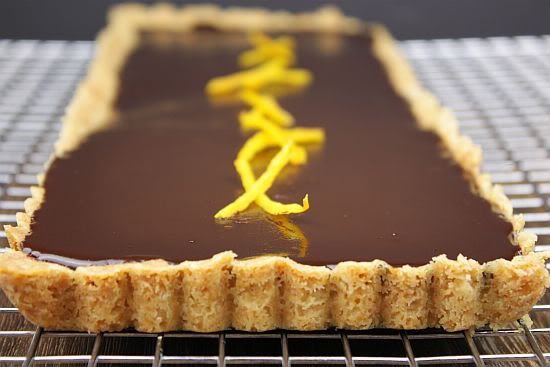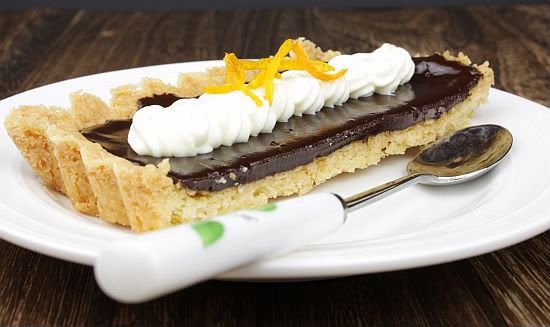The original recipe actually called for an egg beaten over simmering water and then boiling water added to the mixture. This was then added to the melted chocolate. I tried this out but somehow the egg became a bit scrambled. Furthermore it had a very strong egg yolk smell which I didn't really fancy. I ended up throwing the egg mixture away and omitted it altogether from the recipe. With this change, the tart filing itself somewhat resembles chocolate ganache. I can't say that I hated it, in fact it was the opposite! It was eating pure dark chocolate at it's best.

Bittersweet Citrus Tart with Jasmine Rose Petal Cream
Recipe Adapted from "Pure Dessert" by Alice Medrich
Makes one 9 inch-round or a 4-by-12-inch rectangular fluted tart
For the topping:
1 cup heavy cream
1 tablespoon good-quality jasmine rose petal tea leaves (you can substitute with your favourite tea leaves but ensure that it compliments with the citrus fruit flavours)
1 teaspoon sugar, or more to taste
For the crust:
113g unsalted butter, melted
20g sugar
/2 teaspoon pure vanilla extract
1/8 teaspoon salt
110g all-purpose plain flour
For the filling:
220g bittersweet or semisweet chocolate, chopped if using block (alternatively you can use chocolate coins. I used 70% cocoa chocolate)
70g unsalted butter, cut into small pieces
1/2 teaspoon each, very lightly packed of grated orange zest and grated pink grapefruit zest
Candied Citrus Peel, for garnish (optional)
For the candied citrus peel:
4 bright-skinned oranges, 2 grapefruit, or 6 to 8 lemons, limes, or tangerines
1 1/2 cups water
150g sugar, plus more for dredging
To Make the Topping:
Make the cold tea infusion for the topping early in the day or a day ahead. Stir the cream and tea leaves together in a bowl. Cover and chill for 8 to 12 hours (or over night). Even if you are not using the cream right away, strain the tea out and discard it after 12 hours. Refrigerate the cream until needed.
To Make the crust:
1) Position a rack in the lower third of the oven and preheat the oven to 350°F (175°C).
2) In a medium bowl, combine the melted butter with the sugar, vanilla, and salt. Add the flour and mix just until well blended. If the dough seems too soft, let it stand for 5 minutes to firm up.
3) Press the dough evenly across the bottom and up the sides of the tart pan. To avoid ending up with extra-thick edges, press the dough squarely into the corners of the pan. Place the pan on a cookie sheet and bake until the crust is a deep golden brown, 20 to 25 minutes; press it down with the back of a spoon or prick it with a fork, if it bubbles up. Let cool completely on a rack before making the filling.

To Make the filling:
1) Place the chocolate, butter and citrus zest in a small heatproof bowl (stainless steel is best). Sit the bowl of a pot of simmering water, making sure that the bottom of the bowl does not touch the water. Stir the chocolate and butter until it is completely melted. Remove from heat and whisk a few times until the ganache is smooth and silky.
2) Pour the ganache filling into the cooled tart shell and spread it evenly. Place in a covered container (or cover with an inverted bowl if you don’t have an appropriate container), and refrigerate at least until the filling is set (about 4 hours), or up to 2 days.
To serve:
1) Remove the tart from the refrigerator 20 - 30 mins before serving to soften the filling and bring back its sheen. Remove the pan sides and place the tart on a platter.
2) Whip the jasmine-infused cream until thickened. Add the sugar (you want the cream only gently sweetened so that the sweetness doesn’t overpower the subtle flavor of the jasmine and the tea) and whip until it holds a soft shape, or a little stiffer if you plan to pipe the cream.
3) Using a pastry bag, decorate the tart with the jasmine cream or serve plain wedges with dollops of cream. If desired, add the Candied Citrus Peel.
Make the candied citrus peel:
1) Use a sharp knife to score the peel of each fruit into quarters (or sixths if using grapefruit), cutting just through the skin from the top to bottom all around. Use your fingers to strip the peel from the fruit. It’s okay if some fruit is left on the peel for now. You should have 3 to 4 cups peel. Save the fruit for another dish.
2) Place the peel in a 3-to-4-quart saucepan and fill the pan with cold water, leaving just enough space for it to boil. Bring the water to a full rolling boil. Drain the peel and dump it into a large bowl of cold water to cool for a minute. Drain and return the peel to the saucepan. Repeat the entire blanching and cooling sequence twice for thin-skinned Meyer lemons or tangerines, three times for oranges, regular lemons, or tangelos, or four times for grapefruit. (Blanching rids the peel of excess harshness and astringency and tenderizes it. The number of blanchings is not cast in stone. With experience, you may increase or decrease the number to get the tenderness and flavor that you like. Even fruit of the same variety varies in texture, skin thickness, and bitterness, so use my guidelines as you will.)
3) After the final blanching and draining, use a small sharp knife to scrape only the mushiest part of the white pith gently from the peel, leaving thicker lemon, orange, and grapefruit peels about 1/4 inch thick and thinner tangerine or Meyer lemon peels about 1/8 inch thick. Cut the peel into strips or triangles or whatever shape you like.
4) Place the peel in a smaller (2-quart) saucepan with the 1 1/2 cups water and the sugar. Bring to a simmer, stirring to dissolve the sugar. Wash the syrup and sugar off the side of the pan with a wet pastry brush or a wad of wet paper towel. Adjust the heat and very gently simmer the peel uncovered, with little or no stirring, very gently until the syrup registers between 220°F and 222°F (104°C and 160°C) and the peel has been translucent for a few minutes — this will take a little more or less than an hour.
5) Remove from the heat and use a slotted spoon to transfer the peel to a rack set over a rimmed baking sheet, to catch the syrup drips. Spread the peel out in one layer and let cool and dry overnight.
6) Dredge the peel in sugar to coat. Stored in an airtight container in the refrigerator, the peel will keep for several months.







15 comments:
Jo, this tart looks to die for. On my KIV file now.
Jo, this tart looks to die for. On my KIV file now.
Love that gleaming chocolate look. Very indulgent indeed!
The piping on the tart is very neat and chic, great piping skills Jo!
Wow...this is so tempting! I need a big slice!
Excellent job! The tart looks wonderful.
That looks AMAAZZINNGG!
Sounds really really good too. Well done!
Wow the jasmine rose petal cream sounds amazing!
How incredibly elegant. Such a lovely dessert to serve with tea when a guest drops by.
It's a sinful indulgence! But who cares? Don't mind to put on some extra calories to exchange for a bite. Hehehe! ;)
That's a beauty! Love the rose petal cream atop..I am sure it goes really good with pure dark chocolate filling.
This must be a tart well-balanced in flavors of bitter and sweet...and citrus.
Such a gorgeous tart! Nice work!
While I'm not overly fond of chocolate I certainly wouldn't turn down a slice of your tart. It does look good.
The egg concoction does seem kinda weird.
~ingrid
The original recipe actually calls for a beaten egg yolk mixed with 1/4 cup of boiling water, then cooked in a bowl in a pan of simmering water. The water in the yolk is a key component, since it allows the mixture to get custardy instead of just cooked-eggy. Then your filling will be slightly creamy instead of just melted chocolate and butter!
Post a Comment